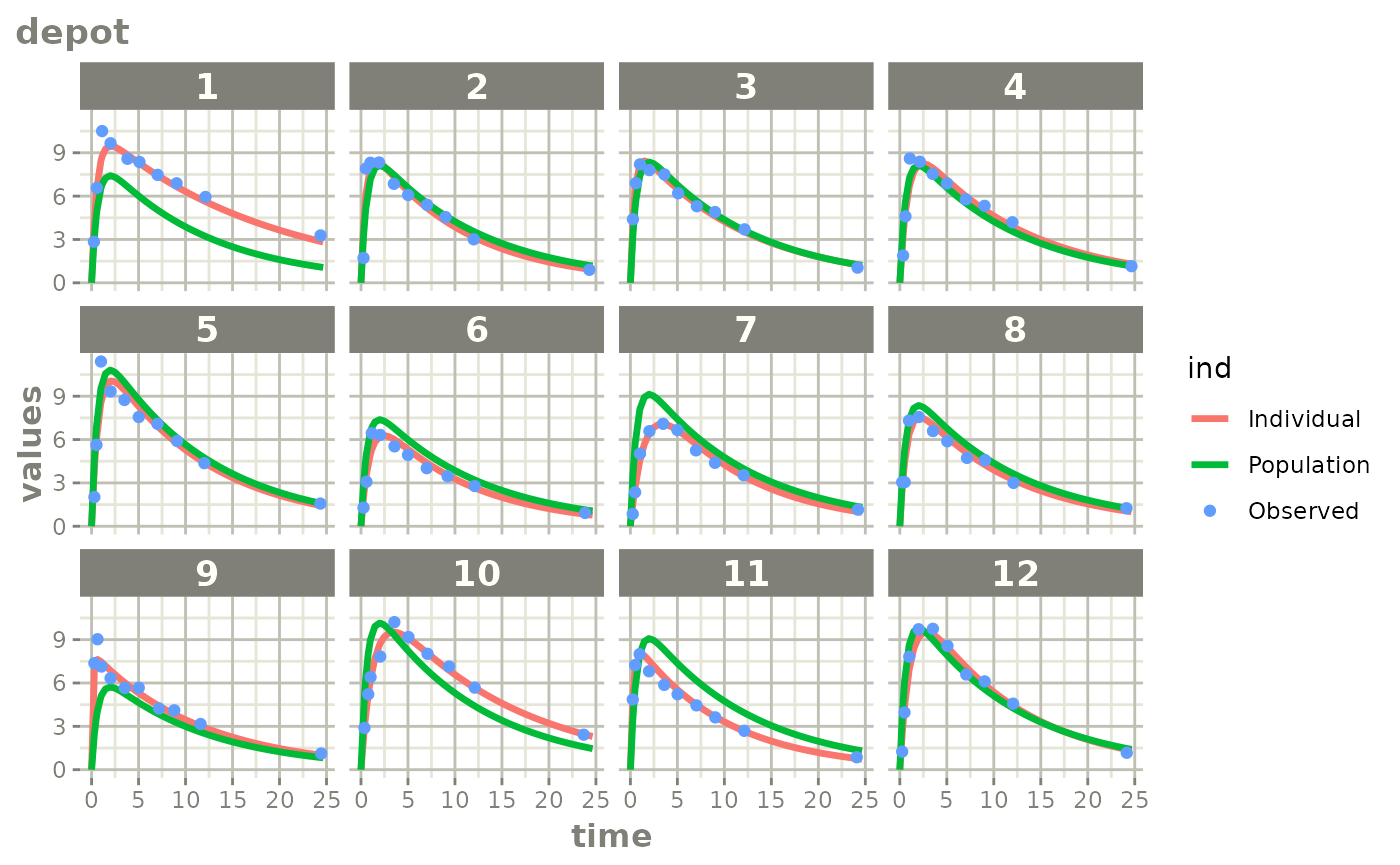
Created Augmented pred/ipred plots with `augPred()`
Source:vignettes/articles/create-augPred.Rmd
create-augPred.RmdThis is a simple process to create individual predictions augmented with more observations than was modeled. This allows smoother plots and a better examination of the observed concentrations for an individual and population.
Step 1: Convert the Monolix model to
rxode2:
library(monolix2rx)
# First we need the location of the monolix mlxtran file. Since we are
# running an example, we will use one of the built-in examples in
# `monolix2rx`
pkgTheo <- system.file("theo/theophylline_project.mlxtran", package="monolix2rx")
# You can use a control stream or other file. With the development
# version of `babelmixr2`, you can simply point to the listing file
mod <- monolix2rx(pkgTheo)
#> ℹ integrated model file 'oral1_1cpt_kaVCl.txt' into mlxtran object
#> ℹ updating model values to final parameter estimates
#> ℹ done
#> ℹ reading run info (# obs, doses, Monolix Version, etc) from summary.txt
#> ℹ done
#> ℹ reading covariance from FisherInformation/covarianceEstimatesLin.txt
#> ℹ done
#> Warning in .dataRenameFromMlxtran(data, .mlxtran): NAs introduced by coercion
#> ℹ imported monolix and translated to rxode2 compatible data ($monolixData)
#> ℹ imported monolix ETAS (_SAEM) imported to rxode2 compatible data ($etaData)
#> ℹ imported monolix pred/ipred data to compare ($predIpredData)
#> ℹ solving ipred problem
#> ℹ done
#> ℹ solving pred problem
#> ℹ doneStep 2: convert the rxode2 model to
nlmixr2
You can convert the model, mod, to a nlmixr2 fit
object:
library(babelmixr2) # provides as.nlmixr2
fit <- as.nlmixr2(mod)
#> → loading into symengine environment...
#> → pruning branches (`if`/`else`) of full model...
#> ✔ done
#> → finding duplicate expressions in EBE model...
#> [====|====|====|====|====|====|====|====|====|====] 0:00:00
#> → optimizing duplicate expressions in EBE model...
#> [====|====|====|====|====|====|====|====|====|====] 0:00:00
#> → compiling EBE model...
#> ✔ done
#> rxode2 4.1.0 using 2 threads (see ?getRxThreads)
#> no cache: create with `rxCreateCache()`
#> → Calculating residuals/tables
#> ✔ done
#> → compress origData in nlmixr2 object, save 7168
#> ℹ monolix parameter history integrated into fit object
fitStep 3: Create and plot an augmented prediction
ap <- augPred(fit)
#> using C compiler: ‘gcc (Ubuntu 13.3.0-6ubuntu2~24.04) 13.3.0’
head(ap)
#> values ind id time Endpoint
#> 1 0.000000 Individual 1 0.000 depot
#> 2 3.726962 Individual 1 0.250 depot
#> 3 6.030526 Individual 1 0.493 depot
#> 4 6.567601 Individual 1 0.570 depot
#> 5 8.414706 Individual 1 0.986 depot
#> 6 8.746028 Individual 1 1.120 depot
# This augpred looks odd:
plot(ap)